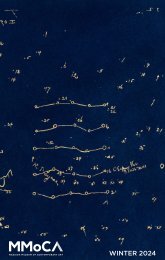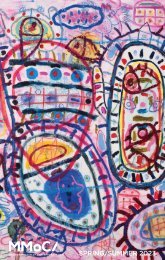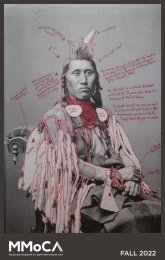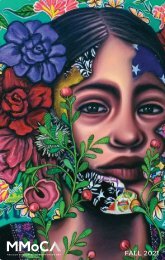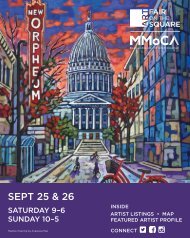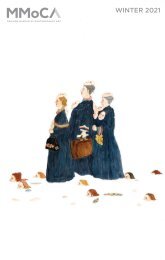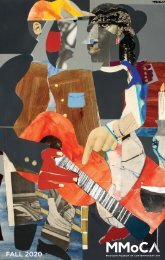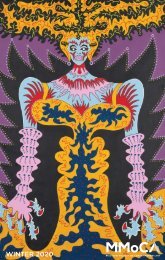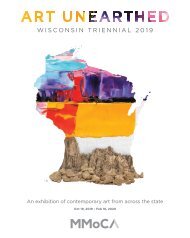Kambui Olujimi: Zulu Time exhibition catalog
This catalog is from the installation of this exhibition at MMoCA. It includes essays by Sampada Aranke, Leah Kolb, and Gregory Volk.
This catalog is from the installation of this exhibition at MMoCA. It includes essays by Sampada Aranke, Leah Kolb, and Gregory Volk.
Create successful ePaper yourself
Turn your PDF publications into a flip-book with our unique Google optimized e-Paper software.
private strategies that effectively sorted and zoned the population by<br />
race. 6 We also ignore the fact that this “urban renewal” plan did not<br />
set forth an adequate strategy for funding and maintaining its massive<br />
public housing project, nor did it stimulate the economic development<br />
necessary for Pruitt-Igoe’s residents to financially succeed. Instead, by<br />
tying the structural upkeep of the building to the tax base of its residents,<br />
city leaders all but guaranteed a continuing cycle of poverty and<br />
deterioration. Further, the 57-acre site within which the 33 apartment<br />
complexes were situated was never integrated into the infrastructure<br />
of downtown St. Louis: the original architectural plans for traffic and<br />
pedestrian thoroughfares connecting Pruitt-Igoe’s community to the<br />
larger city were deemed too expensive to execute. Thus, Pruitt-Igoe and<br />
its inhabitants were left to live in what became a wasteland of concrete<br />
towers isolated from the larger world—a metaphorical prison. 7<br />
<strong>Olujimi</strong> explores the connection between human economies<br />
and imprisonment in another body of work within the <strong>exhibition</strong>, a<br />
series of altered handcuffs collectively titled Killing <strong>Time</strong>. Rather than<br />
being joined by a chain these cuffs are linked together with ornamental<br />
strands of rhinestones and costume jewelry, thereby transforming an<br />
object of restraint into one of wearable fashion. The physicality of these<br />
objects and their implied relationship to the human body, as circling<br />
both the wrists and the neck, functions to animate the works, breathing<br />
life into the law-and-order policies that disproportionately target<br />
and incarcerate men of color. 8<br />
5. Originally conceived of and designed as<br />
segregated housing complexes, Pruitt Igoe<br />
opened in 1955 as racially integrated, owing<br />
to the landmark 1954 Supreme Court ruling<br />
in Brown vs. Board of Education, which<br />
deemed unconstitutional the legal practice of<br />
“separate but equal” segregation. In practice,<br />
however, racial integration within Pruitt-Igoe<br />
remained minimal, and segregation became<br />
a de facto reality: by the late 1960s, Pruitt<br />
Igoe’s population was 98% Black. This can be<br />
attributed to many factors, including whiteflight<br />
to the suburbs and city’s long history<br />
of racism and segregated housing practices.<br />
See: Elizabeth Birmingham, “Refraining the<br />
ruins: Pruitt-Igoe, Structural Racism, and<br />
African American Rhetoric as a Space for<br />
Cultural Critique,” Western Journal of Communication<br />
63, no. 3 (1999): 291-309; Mary<br />
C. Comerio, “Pruitt Igoe and Other Stories,”<br />
Journal of Architectural Education 34, no. 4<br />
(1981): 26-31.<br />
6. The 1949 Housing Act that funded the<br />
development of Pruitt-Igoe was used as a<br />
tool of racial segregation and as justification<br />
for the clearance of impoverished neighborhoods<br />
in downtown St. Louis. Discriminatory<br />
practices such as redlining further deepened<br />
existing patterns of racial segregation.<br />
The Myth of Pruitt-Igoe, directed by Chad<br />
Freidrichs (2011; St. Louis, MO: First Run<br />
Features, 2012), DVD.<br />
7. For a more comprehensive evaluation on the<br />
social, political, and economic forces that<br />
contributed to the failure of Pruitt-Igoe,<br />
see, for example: Katherine G. Bristol, “The<br />
Pruitt-Igoe Myth,” Journal of Architectural<br />
Education 44, no. 3 (1991): 163-71.<br />
21






